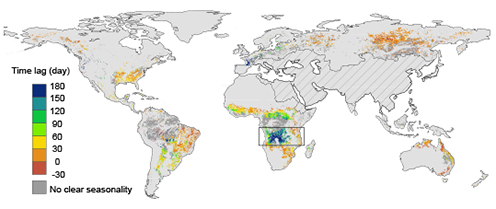Satellite observations reveal secrets of dry tropical forest greening
This surprising phenomenon has been revealed for the first time using satellite observations, mainly in the African region of Miombo, by researchers form University of Copenhagen and French scientists. These findings, vas published on in Nature Ecology and Evolution in August, and will help researchers improve current Earth system models (which do not fully account for plant hydraulic mechanisms) and future climate change and water cycle projections in these regions of the world.
What are the relationships between plant water storage and leaf development? Are both variables closely related in time and space across the Earth’s surface? These are critical questions to improve vegetation-atmosphere feedback in Earth system models and predict ecosystem responses to climate change.
A discovery in the African tropical forest of Miombo
Using satellite observations, the study conducted by the University of Copenhagen and INRA, in collaboration with the CEA, CNRS, CNES and Bordeaux Science Agro, demonstrated that seasonal variations in plant water storage and leaf development are highly synchronous in boreal and temperate regions. However, more surprisingly, the researchers showed that these variations are highly asynchronous in dry tropical forests, where an increase in plant water storage precedes vegetation greening by 25 to 180 days. The study focused on the Miombo woodlands, which cover an immense surface area of more than 2.7 million square kilometres to the south of the African rainforests. Satellite observations of this region clearly show that the leaf area index (LAI) begins to increase several weeks before the rainy season begins, a clear sign of “pre-rain” green up that has already been documented in numerous studies. The mechanisms behind this phenomenon are not yet fully understood but likely involve large construction costs to the plants, which must invest in their rooting system to access deep ground water and in their woody stems to increase their water storage capacity.
The novelty comes from observations of the L-band vegetation optical depth (L-VOD) index (a crucial indicator of the plant water content dynamic) from the European Space Agency (ESA)-CNES SMOS satellite that show that vegetation in Miombo takes up water at the end of the rainy season (when transpiration losses decreases) and stores it in woody tissues during most of the dry season until the emergence of new leaves a few weeks before rain starts. This early leaf flushing has physiological and ecological advantages, reducing the time lag between the onset of the rainy season and that of photosynthetic activity. This intriguing hydraulic behaviour had previously been seen in in situ experiments of a few trees in dry tropical forests, particularly in Costa Rica. However, this new study is the first demonstrating that this is a large-scale phenomenon, visible over forested areas as large as the Miombo woodlands, as well as in the northern African woodlands and the Brazilian Cerrado.
Moreover, these physiological and hydrological processes are still not included in Earth system models. The new L-VOD data set will be key for improving the next generation of Earth system models, leading to more robust projections of the future climate and water cycle in these regions of the world.

A large set of satellite observations
This study was based on a large set of satellite observations that aim to characterise the time variations in key hydrological and vegetation parameters at the ecosystem scale. The research benefited from the new SMOS-IC data set of the vegetation index referred to as L-band vegetation optical depth, or L-VOD, retrieved from space-borne observations of the ESA-CNES SMOS satellite. This index is closely related to the vegetation water content (VWC, kg/m2) of the whole canopy layer. More specifically, along with the L-VOD (a proxy of vegetation water storage), the other variables considered in the study include leaf area index (LAI) retrieved from optical satellite observations and used to parameterise foliar phenology, terrestrial groundwater storage anomalies (TWS) retrieved from GRACE satellites, surface soil moisture, rainfall and transpiration. Surface soil moisture observations considered here were retrieved simultaneously with L-VOD from the multi-angular SMOS observations.
Read the article in Nature Ecology and Evolution
Contact
Feng Tian
PhD student
E-mail: feng.tian@nateko.lu.se
Rasmus Fensholt
Professor
E-mail: rf@ign.ku.dk
Phone: +45 35 32 25 26
Anette Bill-Jessen
Communications Coordinator
E-mail: anbj@ign.ku.dk
Phone: +45 93 51 13 70
